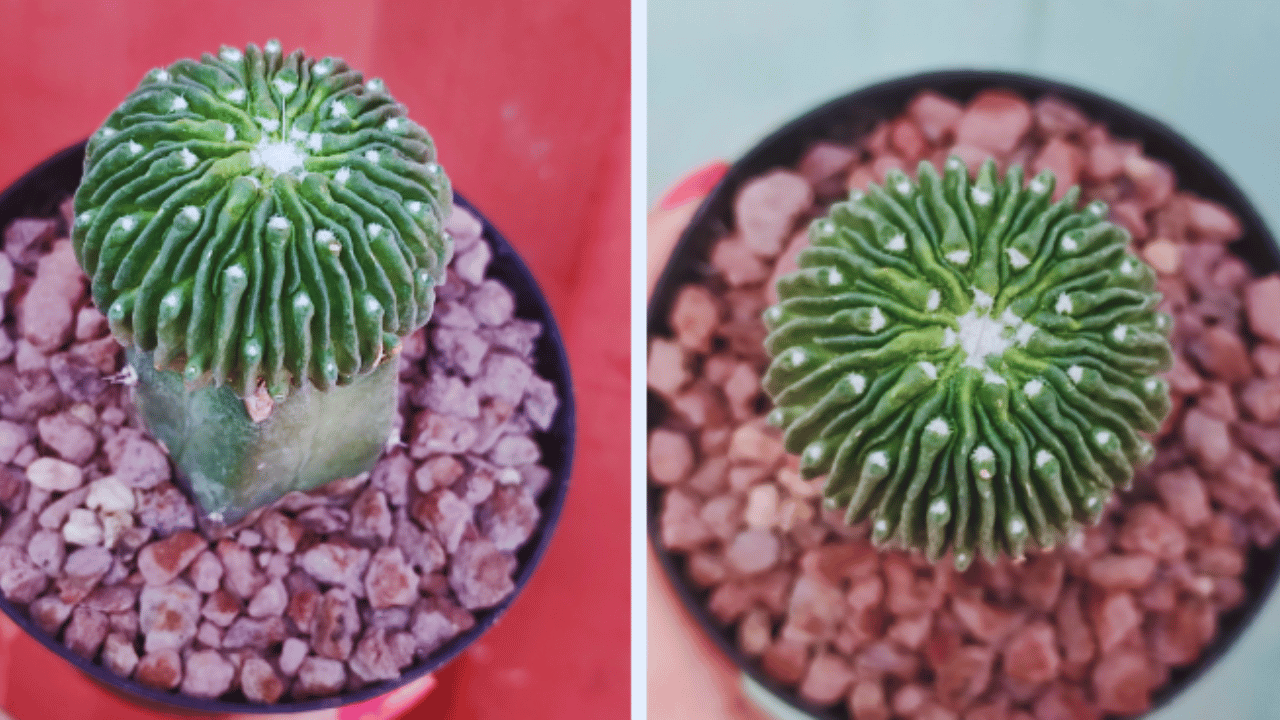What sets the sperm cactus apart from other members of the cactus family is not just its shape, but its epiphytic nature. Unlike the classic image of a cactus growing in the desert sand, the sperm cactus often clings to trees in its natural habitat. This unique behavior gives it a distinct edge in indoor gardening, especially when hung in baskets or mounted on decorative boards.
Over time, it has also earned favor for its beautiful, tubular flowers that bloom in vibrant pinks and purples. These flowers usually emerge in spring or early summer and can be surprisingly fragrant. Whether you’re a new plant parent or an experienced cactus collector, the sperm cactus offers a rewarding and low-maintenance experience that adds flair to any home.
About Sperm Cactus

The sperm cactus, scientifically known as Disocactus flagelliformis, is one of the most unusual and visually captivating plants in the cactus family. With its long, trailing stems and fuzzy appearance, it resembles tiny tendrils or even sperm cells—hence the quirky nickname. Native to Mexico and parts of Central America, this cactus thrives in semi-arid climates and is a popular choice among succulent lovers and houseplant enthusiasts.
Unique Features of the Sperm Cactus
The sperm cactus isn’t just a catchy name—it boasts a range of distinct features that make it a conversation starter. The first thing you’ll notice is its trailing stems, which can grow up to several feet long. These stems are slender, covered in tiny spines, and curve naturally, making them perfect for hanging baskets. The overall look resembles flowing hair or soft green ropes, offering a cascade of greenery when allowed to drape.

Another notable feature is its blooming habit. In the right conditions, the sperm cactus produces funnel-shaped flowers, typically in hues of pink, red, or purple. These flowers are most active during the spring and can last for several days, emitting a faint sweet scent. While each flower may not last long, the plant usually produces them in clusters, creating a dazzling display.
Unlike most cacti, the sperm cactus does not thrive in dry, harsh desert environments. It prefers slightly humid conditions and indirect light, reflecting its origins in shaded forest areas. It’s also more flexible in terms of placement—working well in hanging pots, vertical gardens, or even mounted displays. These attributes make it a decorative favorite, especially for modern urban homes where greenery must complement aesthetics.
Different Varieties and Species
While Disocactus flagelliformis is the most well-known species referred to as the sperm cactus, there are other relatives in the cactus family that share similar features. Some growers loosely categorize other epiphytic cacti with trailing habits under the “sperm cactus” umbrella. Let’s explore a few related species and cultivars:
- Disocactus flagelliformis – The true sperm cactus. It has thin, rope-like stems and bright magenta-pink blooms.
- Disocactus ackermannii – Known for broader, flatter stems and striking red flowers. It’s a cousin in the same genus.
- Epiphyllum hybrids – While not technically sperm cactus, these have similar growing habits and flower types.
- Aporocactus martianus – Sometimes mistaken for the sperm cactus due to its shape, but with more prominent ribs.
Ideal Climate and Growing Zones
If you’re wondering whether the sperm cactus will thrive in your area, the good news is that it’s highly adaptable—especially as a houseplant. In the wild, it grows in the warm, semi-humid forests of Mexico, often attached to trees. That tells us a lot about what kind of environment it prefers.
The sperm cactus thrives in USDA hardiness zones 10 to 11, which include areas that rarely experience frost. If you live in such a zone, you can grow it outdoors year-round. However, in cooler regions, it’s best to keep it as an indoor plant or bring it inside during winter. This cactus cannot tolerate freezing temperatures, and prolonged exposure to frost can be fatal.
Ideal temperature ranges for sperm cactus growth are between 60°F to 80°F (15°C to 27°C). It prefers moderate humidity and can handle some dryness, but extreme arid conditions might cause it to shrivel. During winter, the plant goes into a rest period and should be kept cooler (around 50°F) to encourage spring blooming.
When it comes to positioning, avoid placing it in spots with direct afternoon sun or near heating vents. Bathrooms, sunrooms, or shaded patios (if outdoors) work perfectly. You can even simulate its natural environment by hanging it near a bright window with filtered light and occasional misting.
Best Soil for Sperm Cactus

One of the most crucial factors in the health of your sperm cactus is soil quality. This plant isn’t too picky, but it does demand one thing above all: excellent drainage. Root rot is the most common killer of this plant, and it almost always begins with soggy soil.
The best soil mix is a lightweight, airy cactus or succulent mix, preferably one that contains components like:
- Perlite
- Orchid bark
- Coarse sand
- Coco coir or peat moss
You can either purchase a ready-made cactus mix from a garden center or make your own by combining two parts potting soil with one part perlite and one part sand or bark. This creates a breathable medium that retains just enough moisture without staying wet.
The ideal pH level for sperm cactus soil is slightly acidic to neutral, ranging from 6.0 to 7.0. If you’re unsure about the pH level, inexpensive soil test kits can be found online or at most
Potting and Repotting Guide
Potting your sperm cactus correctly is a key step in ensuring healthy growth. Since this plant prefers to grow in hanging baskets or elevated containers, choosing the right pot plays a big role in how well it thrives. A shallow pot with excellent drainage is ideal. Hanging pots or containers with side holes are even better, as they allow the trailing stems to hang naturally without obstruction.
When you’re potting the plant for the first time, use a light, well-draining cactus mix, as discussed in the previous section. Avoid compact soils or standard indoor potting soil unless amended with perlite or sand. The sperm cactus has shallow roots and doesn’t require a deep container, but width is important to accommodate its spread.
Now, let’s talk about repotting. While the sperm cactus doesn’t need frequent repotting, doing it every 2 to 3 years helps refresh the soil and gives the roots more space to expand. Signs that it’s time to repot include roots growing out of the drainage holes, water sitting on top of the soil, or stunted growth.
Light Requirements
The sperm cactus loves light—but not just any light. It prefers bright, indirect sunlight, which mimics the dappled light it receives in its natural forest habitat. If you’re growing it indoors, place it near an east-facing window or a few feet away from a south-facing one where it won’t receive harsh afternoon rays.
Too much direct sunlight can scorch the stems, causing them to turn yellow or brown. On the other hand, insufficient light will result in leggy, pale growth, and the plant might stop blooming altogether. A balanced light exposure of about 6 hours a day is perfect for encouraging both growth and flowering.
If you’re growing the plant outdoors, find a spot with partial shade—like under a tree canopy or on a shaded patio. In cooler climates, a greenhouse or sunroom can offer the perfect environment year-round.
During winter, when natural light decreases, consider using grow lights to supplement the plant’s needs. Fluorescent or LED grow lights placed about 12 inches above the plant can keep it happy through the dark months. Rotate the pot every week to ensure all sides of the plant get equal exposure.
Watering Your Sperm Cactus
Watering the sperm cactus is a delicate balance—too much and you risk rot, too little and the stems can shrivel. The key is to let the soil dry out slightly between waterings. A good rule of thumb is to water thoroughly when the top 1–2 inches of soil feels dry to the touch.
During the growing season (spring and summer), your cactus will be thirstier. Water about once a week, but always check the soil first. In winter, reduce watering to once every 2–3 weeks, as the plant enters dormancy and its water needs drop significantly.
Make sure excess water drains completely from the pot. Never let the plant sit in a saucer of water, as this can cause root rot, the most common issue with cacti. Overwatering symptoms include yellowing stems, soft or mushy spots, and a foul smell. Underwatering, on the other hand, can cause wrinkled stems and slow growth.
Fertilizing Tips for Healthy Growth
Though the sperm cactus is a low-maintenance plant, it does benefit from regular feeding during the growing season. Fertilizing helps boost bloom production and supports the development of strong, healthy stems.
Use a balanced, water-soluble fertilizer with a ratio like 10-10-10 or 20-20-20 diluted to half strength. Apply it once every 4 weeks from early spring to late summer. You can also opt for a cactus-specific fertilizer, which is lower in nitrogen and better suited for succulent varieties.
In fall and winter, stop fertilizing completely to allow the plant to rest. Over-fertilization during dormancy can stress the plant, leading to nutrient buildup and root damage. Always water the plant before feeding to avoid fertilizer burn, especially if you’re using synthetic products.
If you’re into organic gardening, try feeding your sperm cactus with compost tea, worm castings, or diluted fish emulsion. These provide nutrients gently and naturally over time.
Pruning and Maintenance
The sperm cactus doesn’t require aggressive pruning, but a little maintenance goes a long way in keeping it healthy and attractive. Regular pruning helps control the plant’s shape, encourages new growth, and prevents overcrowding in hanging pots.
Begin by inspecting the plant every few weeks. Remove any dead, discolored, or damaged stems using sterilized scissors or pruning shears. This not only improves appearance but also prevents disease from spreading. If the stems have grown too long or tangled, you can trim them back by a few inches to maintain a tidy look.
Always prune in the spring or early summer, which is the active growing period. Avoid cutting during fall or winter unless absolutely necessary, as the plant may struggle to heal during dormancy.
You can also propagate trimmed stems by letting them callous for a few days and then planting them in soil. This makes pruning both a maintenance task and a propagation opportunity.
Occasionally dust or rinse the plant (lightly!) to remove debris that may block sunlight. Also, inspect regularly for pests like mealybugs or spider mites, especially if the plant is indoors or placed near other houseplants.
Common Pests and Problems
Like most houseplants, the sperm cactus is not immune to pests or diseases. Although it’s generally low-maintenance, issues can arise if it’s kept in poor conditions or exposed to infested plants. The most common pests to watch for include mealybugs, spider mites, and scale insects.
Mealybugs appear as small white cottony clusters around stem joints. They suck plant sap, causing stems to weaken and eventually die back. Spider mites are nearly invisible to the naked eye but leave behind fine webs and speckled, discolored patches on stems. Scale insects show up as small, brown, oval bumps that stick to the cactus and are tough to remove.
To treat these pests:
- Use a cotton swab dipped in rubbing alcohol to dab affected areas.
- Spray the plant with insecticidal soap or neem oil weekly until pests are gone.
- Quarantine any new plants before introducing them to your collection.
Beyond pests, the sperm cactus may suffer from root rot, typically caused by overwatering or poor drainage. Symptoms include black, mushy roots and wilting stems. If detected early, remove the plant from the pot, cut off rotten roots, and repot in fresh, dry soil.
Another occasional issue is sunburn, where direct sunlight causes bleached or scorched stems. If this happens, move the plant to a shadier location. Nutrient deficiencies may also cause weak growth, which can be corrected by balanced fertilization.
Propagation Techniques
One of the joys of owning a sperm cactus is how easy it is to propagate. You can create new plants from your existing one using simple stem cuttings. Propagation is best done in spring or early summer, when the plant is actively growing.
Step-by-Step Guide to Propagation:
- Choose a healthy stem — Select a 4–6 inch segment that’s firm and free from pests or damage.
- Cut with a clean tool — Use sterilized scissors or pruning shears to make a clean cut.
- Let the cutting dry — Place the cutting in a shaded, dry area for 3–5 days until a callus forms on the cut end. This step prevents rot when planted.
- Plant in well-draining soil — Insert the calloused end into a cactus mix and water lightly.
- Place in bright, indirect light — Keep the soil slightly moist but not soggy during rooting.
Blooming Season and Flower Care
One of the most rewarding aspects of growing a sperm cactus is watching it bloom. These cacti typically flower in spring or early summer, but it requires the right care and environment to bloom consistently.
The blooms are usually trumpet-shaped, ranging in color from bright pink to purple, and sometimes even orange depending on the variety. They open during the day and may close by night, often lasting only a few days. However, a healthy plant may produce several blooms at once, creating a striking visual effect.
Tips to Encourage Blooming:
- Cool winter rest – Reduce watering and keep the plant around 50°F (10°C) for 6–8 weeks in winter.
- Adequate light – Provide 6 hours of bright, indirect sunlight daily.
- Phosphorus-rich fertilizer – Use bloom boosters with higher phosphorus content.
- Proper pruning – Trim old stems to stimulate new flower-bearing shoots.
If your plant hasn’t bloomed in over a year, consider adjusting one or more of these factors. Sometimes just moving the pot to a sunnier location or reducing winter watering can make a huge difference.
Benefits of Having a Sperm Cactus
Besides its aesthetic value, the sperm cactus offers multiple benefits that make it a worthy addition to any home or garden. Here are just a few:
1. Air Purification:
Like many succulents, the sperm cactus can help purify indoor air by absorbing toxins and releasing oxygen. It’s a small but meaningful contribution to a healthier home environment.
2. Low Maintenance:
This plant thrives on neglect. It doesn’t need constant watering or feeding and is highly forgiving of occasional mistakes, making it ideal for beginners or busy plant lovers.
3. Decorative Appeal:
Its flowing stems and vibrant blooms make it a perfect hanging plant for balconies, windows, and indoor shelves. It adds a touch of the wild to any space.
4. Pet-Friendly (with caution):
While it’s not toxic to humans, it’s best kept out of reach of pets due to the fine spines that may cause irritation if touched or chewed.
5. Propagation Joy:
Sharing plant cuttings with friends and family is both fun and meaningful. The sperm cactus makes it easy to grow and gift a piece of nature.
Is It Pet and Child Friendly?
The sperm cactus is not known to be toxic to cats, dogs, or humans, which makes it a relatively safe plant to keep indoors. However, caution is still advised. Its fine spines, while not as dangerous as those on desert cacti, can still cause skin irritation or minor discomfort if touched or ingested.
If you have curious pets or small children, it’s best to place the plant in a hanging pot or on a high shelf where it’s visible but not easily reachable. While accidental contact won’t likely lead to serious health issues, avoiding unnecessary pokes or bites is always wise.
As a bonus, because the plant doesn’t drop leaves or release pollen like some flowering houseplants, it’s also a good choice for households with allergies.
Conclusion
The sperm cactus is a beautiful, low-maintenance, and rewarding houseplant that brings both charm and character to any space. Whether you’re new to cacti or an experienced green thumb, this plant offers something for everyone—from dramatic, trailing stems to vibrant springtime blooms. With the right care, your sperm cactus can thrive for years, growing fuller and more impressive with each season.
FAQs
1. How fast does a sperm cactus grow?
The sperm cactus is a moderate grower. Under ideal conditions, it can grow a few inches per year, with trailing stems reaching several feet over time.
2. Why isn’t my sperm cactus blooming?
Lack of blooms is usually due to insufficient light or no cool rest period in winter. Make sure it gets bright indirect sunlight and a rest with lower temperatures and less water.
3. Can I grow sperm cactus outdoors?
Yes, but only in warm climates (USDA zones 10–11). In cooler areas, grow it indoors or bring it inside during winter.
4. Is the sperm cactus toxic to pets?
No, it’s considered non-toxic, but its spines can irritate skin or mouths, so keep it out of reach of pets and children.
5. Can I propagate it in water?
It’s best to propagate sperm cactus in soil, but some people have success in water as long as you transplant it before root rot sets in.







